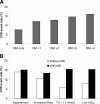Effects of fenofibrate treatment on cardiovascular disease risk in 9,795 individuals with type 2 diabetes and various components of the metabolic syndrome: the Fenofibrate Intervention and Event Lowering in Diabetes (FIELD) study
- PMID: 18984774
- PMCID: PMC2646035
- DOI: 10.2337/dc08-1543
Effects of fenofibrate treatment on cardiovascular disease risk in 9,795 individuals with type 2 diabetes and various components of the metabolic syndrome: the Fenofibrate Intervention and Event Lowering in Diabetes (FIELD) study
Abstract
Objective: We explored whether cardiovascular disease (CVD) risk and the effects of fenofibrate differed in subjects with and without metabolic syndrome and according to various features of metabolic syndrome defined by the Adult Treatment Panel III (ATP III) in subjects with type 2 diabetes in the Fenofibrate Intervention and Event Lowering in Diabetes (FIELD) study.
Research design and methods: The prevalence of metabolic syndrome and its features was calculated. Cox proportional models adjusted for age, sex, CVD status, and baseline A1C levels were used to determine the independent contributions of metabolic syndrome features to total CVD event rates and the effects of fenofibrate.
Results: More than 80% of FIELD participants met the ATP III criteria for metabolic syndrome. Each ATP III feature of metabolic syndrome, apart from increased waist circumference, increased the absolute risk of CVD events over 5 years by at least 3%. Those with marked dyslipidemia (elevated triglycerides >or=2.3 mmol/l and low HDL cholesterol) were at the highest risk of CVD (17.8% over 5 years). Fenofibrate significantly reduced CVD events in those with low HDL cholesterol or hypertension. The largest effect of fenofibrate to reduce CVD risk was observed in subjects with marked dyslipidemia in whom a 27% relative risk reduction (95% CI 9-42, P = 0.005; number needed to treat = 23) was observed. Subjects with no prior CVD had greater risk reductions than the entire group.
Conclusions: Metabolic syndrome components identify higher CVD risk in individuals with type 2 diabetes, so the absolute benefits of fenofibrate are likely to be greater when metabolic syndrome features are present. The highest risk and greatest benefits of fenofibrate are seen among those with marked hypertriglyceridemia.
Figures



References
-
- Klein BEK, Klein R, Lee KE: Components of the metabolic syndrome and risk of cardiovascular disease and diabetes in Beaver Dam. Diabetes Care 25:1790–1794, 2002 - PubMed
-
- Expert Panel on Detection, Evaluation, and Treatment of High Blood Cholesterol in Adults: Executive summary of the Third Report of the National Cholesterol Education Program (NCEP) Expert Panel on Detection, Evaluation, and Treatment of High Blood Cholesterol in Adults (Adult Treatment Panel III). JAMA 285:2486–2497, 2001 - PubMed
-
- Assmann G, Schulte H, Seedorf U: Cardiovascular risk assessment in the metabolic syndrome: results from the Prospective Cardiovascular Munster (PROCAM) Study. Int J Obes 32:S11–S16, 2008 - PubMed
-
- Wilson PWF, Meigs JB: Cardiometabolic risk: a Framingham perspective. Int J Obes 32:S17–S20, 2008 - PubMed
-
- Keech A, Simes RJ, Barter P, et al.: Effects of long-term fenofibrate therapy on cardiovascular events in 9795 people with type 2 diabetes mellitus (the FIELD study): randomised controlled trial. Lancet 366:1849–1861, 2005 - PubMed
Publication types
MeSH terms
Substances
LinkOut - more resources
Full Text Sources
Other Literature Sources
Medical
Miscellaneous

